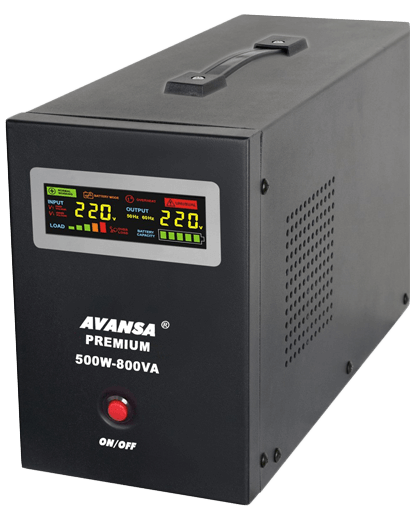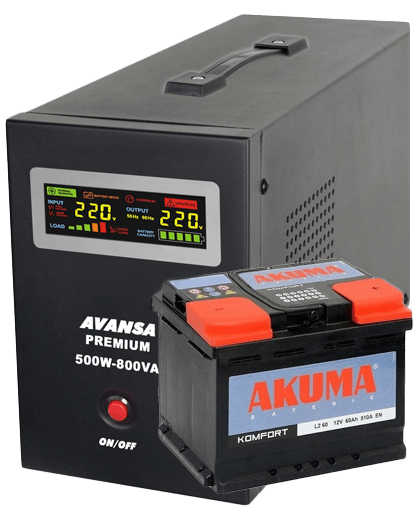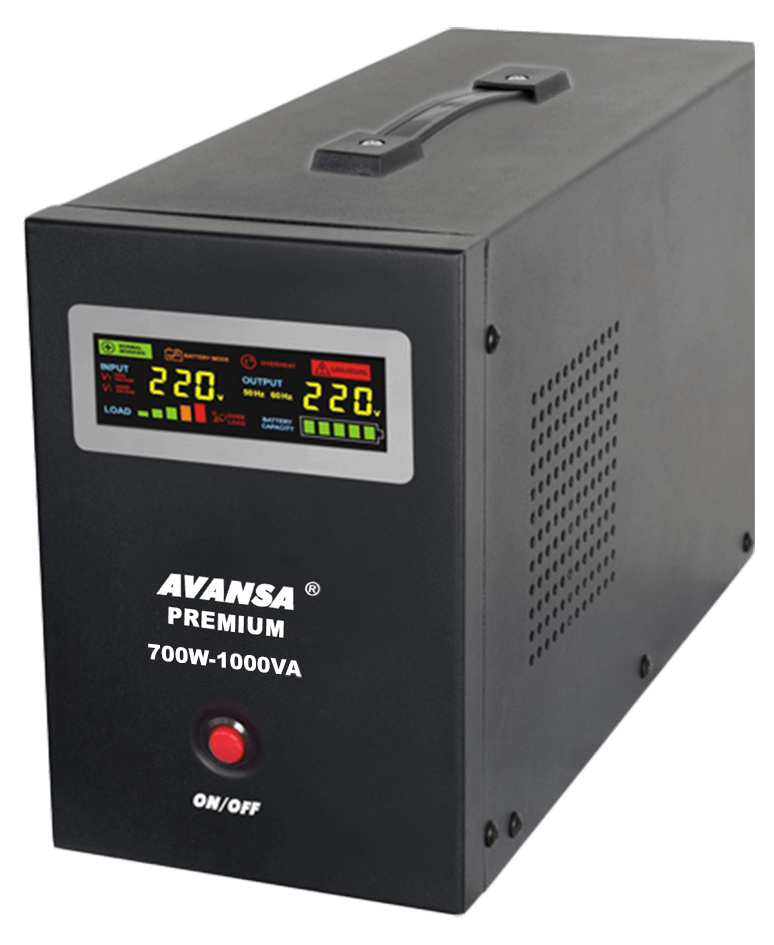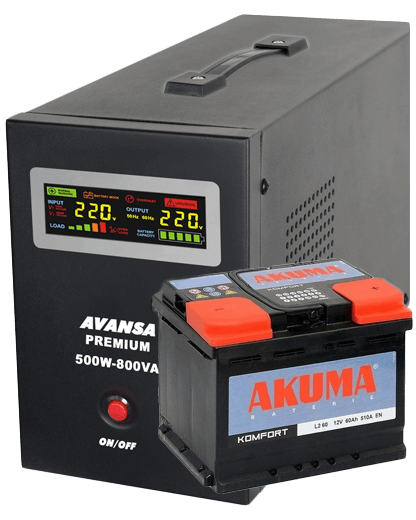Power supplies AVANSA
The back-up power supply is suitable for appliances with a max. output of 350 W in the sum.

Avansa 500 W - 800 VA
- Maximum capacity: 800 VA
- Maximum rated output: 500W
- Main input Power: 150 – 270 VCA
- Input frequency: 45 – 65 Hz
- Output power: 207 – 241 VCA
- Input frequency: 50 – 60 Hz
- Switching time: <4ms
- Battery capacity: 12V DC
- Overload protection: 110% 130% (30 seconds)
- Consumption in idle mode: 22W
- Dimensions (H / W / H): 18,5x14,5x34 cm
- Purchase

Avansa 500 W - 800 VA + batéria 12V
- Maximum capacity: 800 VA
- Maximum rated output: 500W
- Main input Power: 150 – 270 VCA
- Input frequency: 45 – 65 Hz
- Output power: 207 – 241 VCA
- Input frequency: 50 – 60 Hz
- Switching time: <4ms
- Battery capacity: 12V DC
- Overload protection: 110% 130% (30 seconds)
- Consumption in idle mode: 22W
- Dimensions (H / W / H): 18,5x14,5x34 cm
- Purchase

Avansa 700 W - 1000 VA
- Maximum capacity: 1000 VA
- Maximum rated output: 700W
- Main input Power: 150 – 270 VCA
- Input frequency: 45 – 65 Hz
- Output power: 207 – 241 VCA
- Input frequency: 50 – 60 Hz
- Switching time: <4ms
- Battery capacity: 12V DC
- Overload protection: 110% 130% (30 seconds)
- Consumption in idle mode: 22W
- Dimensions (H / W / H): 18,5x14,5x34 cm
- Purchase

Avansa 700 W - 1000 VA + batéria 12V
- Maximum capacity: 1000 VA
- Maximum rated output: 700W
- Main input Power: 150 – 270 VCA
- Input frequency: 45 – 65 Hz
- Output power: 207 – 241 VCA
- Input frequency: 50 – 60 Hz
- Switching time: <4ms
- Battery capacity: 12V DC
- Overload protection: 110% 130% (30 seconds)
- Consumption in idle mode: 22W
- Dimensions (H / W / H): 18,5x14,5x34 cm
- Purchase

Avansa 1050 W - 1500 VA
- Maximum capacity: 1500 VA
- Maximum rated output: 1050W
- Main input Power: 150 – 270 VCA
- Input frequency: 45 – 65 Hz
- Output power: 207 – 241 VCA
- Input frequency: 50 – 60 Hz
- Switching time: <4ms
- Battery capacity: 12V DC
- Overload protection: 110% 130% (30 seconds)
- Consumption in idle mode: 22W
- Dimensions (H / W / H): 18,5x14,5x34 cm
- Purchase
AKUMA battery properties
AKUMA Comfort+ 12V 46Ah 450A
Properties
- Maintenance-free car battery
- Lead / calcium technology
- Chech the state with a magical eye
- Increased starting current
- Enhanced lid with central degassing system
- Low self-discharge
- Higher corrosion resistance
Technical parameters
- Capacity: 46 Ah
- Exc. current at -18°C: 450 A
- Pole types: 1
- Dimensions: 207 x 175 x 175 mm
- Mounting: B13 / B15
AKUMA Comfort+ 12V 55Ah 480A
Properties
- Maintenance-free car battery
- Lead / calcium technology
- Chech the state with a magical eye
- Increased starting current
- Enhanced lid with central degassing system
- Low self-discharge
- Higher corrosion resistance
Technical parameters
- Capacity: 55 Ah
- Exc. current at -18°C: 480 A
- Pole types: 1
- Dimensions: 207 x 175 x 190 mm
- Mounting: B13
Important information and notices.
WARNING! Be careful when handling the battery. Attach metal objects (such as bracelets, chains, watches, rings ... etc.) when attaching a backup source. Because of the electrical current shortage and the subsequent disposal of metallic materials to the consumer's body. When connecting the battery, keep the polarization: the red (+ positive) cable is connected to the + terminal and the black (-negative) wire is connected to the terminal -. The metal connectors are used to connect the cable to the battery terminals. Before connecting, it is recommended to clean the battery contacts with a brush. Tighten the connector using the key to secure the fixed contact.
Install the UPS in a dry place, free of humidity, out of reach of water or snow. The location of the backup UPS must be large enough to prevent the backup system cooling system. Furthermore, this site should be free of dust or coal dust that could block the back-up fan. At the installation site, it should be well ventilated to prevent overheating. To avoid electric shock, make sure that all cables are in good condition and free of isolation. Running a UPS may cause sparking. The backup source should not be installed in flammable environments.
WARNING! The UPS only works when it is connected to an external battery. It should not be used without connecting the battery. After connecting the battery, plug the main power cable into an outlet (230V, 50Hz) with grounding. On the back of the power source, connect the device that you want to function in the event of a power failure. Follow these steps: connect the battery, connect the mains power supply, and then connect the consumer (device) to the backup power supply (UPS). To turn on the power, press and hold the power button (ON / OFF) for 4 seconds.
System operation starts with automatic battery voltage detection. If the battery voltage drops below 10.8V, the battery may be damaged and can not be started.
In the event of a power outage or if its parameters are not within the normal range, the UPS automatically switches to the battery. Switching the backup battery to the battery will appear on the Backup UPS (UPS) display. The device (UPS) announces that the backup battery (UPS) switches to both the battery and the audio signal.
When the battery voltage falls below the minimum value (the battery is discharged), the backup source (UPS) will increase the frequency of the warning sound and disconnect the power.
If the device that is connected to the UPS (Power Supply) exceeds the maximum power by 110%, the UPS will start to emit an intermittent acoustic signal and automatically shut off. For inductive devices (such as water pumps and electric motors), it is recommended to use a device up to 50% of maximum power from a UPS, as inductive devices may need a double power at startup.
WARNING! Danger! Do not touch the battery terminals during operation.
To stop the backup UPS, hold the ON / OFF button for 4 seconds. The backup source then emits a beep and stops. To extend the life of the battery, it is recommended to perform a blank and full battery cycle at least once every 2 months. Perform this operation even if there were no outages within 2 months and the battery was still fully charged.
WARNING! It is only a safety device that is used only in case of a power failure. When using this device, please do not leave it near the fuel.
Main functions:
- The UPS will stop in case of a low battery. When the battery is discharged to 10.8V, the backup power supply disconnects the power supply to prevent battery damage. A quick alarm sounds: - Overload protection: If the UPS load exceeds 110% of the rated power, the UPS stops to prevent damage.
- Short-circuit protection: The UPS stops in case of a short circuit. - The voltage regulator (AVR) ensures a constant voltage for the devices at a given interval. Turn on the battery: the system switches to battery and provides continuous power for the device. -Bypass function.
- Automatization: If the power supply is unusual, the backup power source will automatically switch to the battery. - Conversion to start a job: In some cases, a higher startup power is needed than the rated power of the UPS. In this case, the UPS will resolve this problem by delivering 110% of its capacity. After delivery, it turns off.
- High charging current: The initial charging current is about 10A. It charges the battery in shorter time than normal chargers.
- Keeping the battery in standby mode: When the battery is fully charged, the backup power supply (UPS) keeps the battery charged. To achieve optimal results, the battery must have a capacity within the range of 50 Ah -150 Ah. Do not use a battery with a capacity of less than 50Ah, as the initial UPS (up to 10A) may reduce its service life.
For 100W consumption:
- A backup power supply (UPS) with a 65 Ah battery will work for 3,5 hours.
- A backup power supply (UPS) with a 120 Ah battery will work for 6,5 hours.
- A backup power supply (UPS) with a 150 Ah battery will work for 8 hours.
For 200W consumption:
- A backup power supply (UPS) with a 65 Ah battery will work for 2 hours.
- A backup power supply (UPS) with a 120 Ah battery will work for 3 hours.
- A backup power supply (UPS) with a 150 Ah battery will work for 4 hours.
For 300W consumption:
- A backup power supply (UPS) with a 65 Ah battery will work for 1,5 hours.
- A backup power supply (UPS) with a 120 Ah battery will work for 2,5 hours.
- A backup power supply (UPS) with a 150 Ah battery will work for 3 hours.





